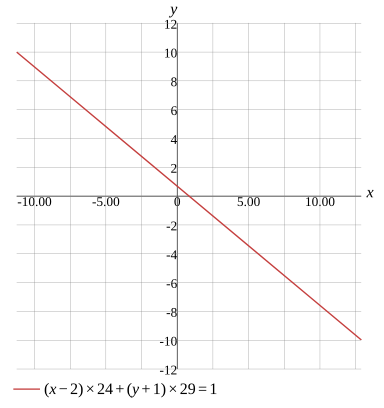Question
Function
Find the x-intercept/zero
Find the y-intercept
Find the slope
x=65
Evaluate
(x−2)×24+(y+1)×29=1
To find the x-intercept,set y=0
(x−2)×24+(0+1)×29=1
Simplify
More Steps


Evaluate
(x−2)×24+(0+1)×29
Removing 0 doesn't change the value,so remove it from the expression
(x−2)×24+1×29
Multiply the terms
24(x−2)+1×29
Any expression multiplied by 1 remains the same
24(x−2)+29
24(x−2)+29=1
Move the expression to the left side
24(x−2)+29−1=0
Subtract the numbers
24(x−2)+28=0
Calculate
More Steps


Evaluate
24(x−2)+28
Expand the expression
More Steps


Calculate
24(x−2)
Apply the distributive property
24x−24×2
Multiply the numbers
24x−48
24x−48+28
Add the numbers
24x−20
24x−20=0
Move the constant to the right-hand side and change its sign
24x=0+20
Removing 0 doesn't change the value,so remove it from the expression
24x=20
Divide both sides
2424x=2420
Divide the numbers
x=2420
Solution
x=65
Show Solution

Solve the equation
Solve for x
Solve for y
x=2420−29y
Evaluate
(x−2)×24+(y+1)×29=1
Simplify
More Steps


Evaluate
(x−2)×24+(y+1)×29
Multiply the terms
24(x−2)+(y+1)×29
Multiply the terms
24(x−2)+29(y+1)
24(x−2)+29(y+1)=1
Rewrite the expression
24(x−2)+29y+29=1
Move the expression to the left side
24(x−2)+29y+29−1=0
Subtract the numbers
24(x−2)+29y+28=0
Calculate
More Steps


Evaluate
24(x−2)+29y+28
Expand the expression
More Steps


Calculate
24(x−2)
Apply the distributive property
24x−24×2
Multiply the numbers
24x−48
24x−48+29y+28
Add the numbers
24x−20+29y
24x−20+29y=0
Move the expression to the right-hand side and change its sign
24x=0−(−20+29y)
Subtract the terms
More Steps


Evaluate
0−(−20+29y)
If a negative sign or a subtraction symbol appears outside parentheses, remove the parentheses and change the sign of every term within the parentheses
0+20−29y
Removing 0 doesn't change the value,so remove it from the expression
20−29y
24x=20−29y
Divide both sides
2424x=2420−29y
Solution
x=2420−29y
Show Solution

Testing for symmetry
Testing for symmetry about the origin
Testing for symmetry about the x-axis
Testing for symmetry about the y-axis
Not symmetry with respect to the origin
Evaluate
(x−2)24+(y+1)29=1
Simplify the expression
24(x−2)+29(y+1)=1
To test if the graph of 24(x−2)+29(y+1)=1 is symmetry with respect to the origin,substitute -x for x and -y for y
24(−x−2)+29(−y+1)=1
Solution
Not symmetry with respect to the origin
Show Solution

Rewrite the equation
Rewrite in polar form
Rewrite in standard form
Rewrite in slope-intercept form
r=24cos(θ)+29sin(θ)20
Evaluate
(x−2)×24+(y+1)×29=1
Evaluate
More Steps


Evaluate
(x−2)×24+(y+1)×29
Multiply the terms
24(x−2)+(y+1)×29
Multiply the terms
24(x−2)+29(y+1)
Expand the expression
More Steps


Calculate
24(x−2)
Apply the distributive property
24x−24×2
Multiply the numbers
24x−48
24x−48+29(y+1)
Expand the expression
More Steps


Calculate
29(y+1)
Apply the distributive property
29y+29×1
Any expression multiplied by 1 remains the same
29y+29
24x−48+29y+29
Add the numbers
24x−19+29y
24x−19+29y=1
To convert the equation to polar coordinates,substitute x for rcos(θ) and y for rsin(θ)
24cos(θ)×r−19+29sin(θ)×r=1
Factor the expression
(24cos(θ)+29sin(θ))r−19=1
Subtract the terms
(24cos(θ)+29sin(θ))r−19−(−19)=1−(−19)
Evaluate
(24cos(θ)+29sin(θ))r=20
Solution
r=24cos(θ)+29sin(θ)20
Show Solution

Find the first derivative
Find the derivative with respect to x
Find the derivative with respect to y
dxdy=−2924
Calculate
(x−2)24+(y+1)29=1
Simplify the expression
24x−19+29y=1
Take the derivative of both sides
dxd(24x−19+29y)=dxd(1)
Calculate the derivative
More Steps


Evaluate
dxd(24x−19+29y)
Use differentiation rules
dxd(24x)+dxd(−19)+dxd(29y)
Evaluate the derivative
More Steps


Evaluate
dxd(24x)
Use differentiation rule dxd(cf(x))=c×dxd(f(x))
24×dxd(x)
Use dxdxn=nxn−1 to find derivative
24×1
Any expression multiplied by 1 remains the same
24
24+dxd(−19)+dxd(29y)
Use dxd(c)=0 to find derivative
24+0+dxd(29y)
Evaluate the derivative
More Steps


Evaluate
dxd(29y)
Use differentiation rules
dyd(29y)×dxdy
Evaluate the derivative
29dxdy
24+0+29dxdy
Evaluate
24+29dxdy
24+29dxdy=dxd(1)
Calculate the derivative
24+29dxdy=0
Move the constant to the right-hand side and change its sign
29dxdy=0−24
Removing 0 doesn't change the value,so remove it from the expression
29dxdy=−24
Divide both sides
2929dxdy=29−24
Divide the numbers
dxdy=29−24
Solution
dxdy=−2924
Show Solution

Find the second derivative
Find the second derivative with respect to x
Find the second derivative with respect to y
dx2d2y=0
Calculate
(x−2)24+(y+1)29=1
Simplify the expression
24x−19+29y=1
Take the derivative of both sides
dxd(24x−19+29y)=dxd(1)
Calculate the derivative
More Steps


Evaluate
dxd(24x−19+29y)
Use differentiation rules
dxd(24x)+dxd(−19)+dxd(29y)
Evaluate the derivative
More Steps


Evaluate
dxd(24x)
Use differentiation rule dxd(cf(x))=c×dxd(f(x))
24×dxd(x)
Use dxdxn=nxn−1 to find derivative
24×1
Any expression multiplied by 1 remains the same
24
24+dxd(−19)+dxd(29y)
Use dxd(c)=0 to find derivative
24+0+dxd(29y)
Evaluate the derivative
More Steps


Evaluate
dxd(29y)
Use differentiation rules
dyd(29y)×dxdy
Evaluate the derivative
29dxdy
24+0+29dxdy
Evaluate
24+29dxdy
24+29dxdy=dxd(1)
Calculate the derivative
24+29dxdy=0
Move the constant to the right-hand side and change its sign
29dxdy=0−24
Removing 0 doesn't change the value,so remove it from the expression
29dxdy=−24
Divide both sides
2929dxdy=29−24
Divide the numbers
dxdy=29−24
Use b−a=−ba=−ba to rewrite the fraction
dxdy=−2924
Take the derivative of both sides
dxd(dxdy)=dxd(−2924)
Calculate the derivative
dx2d2y=dxd(−2924)
Solution
dx2d2y=0
Show Solution

Graph
